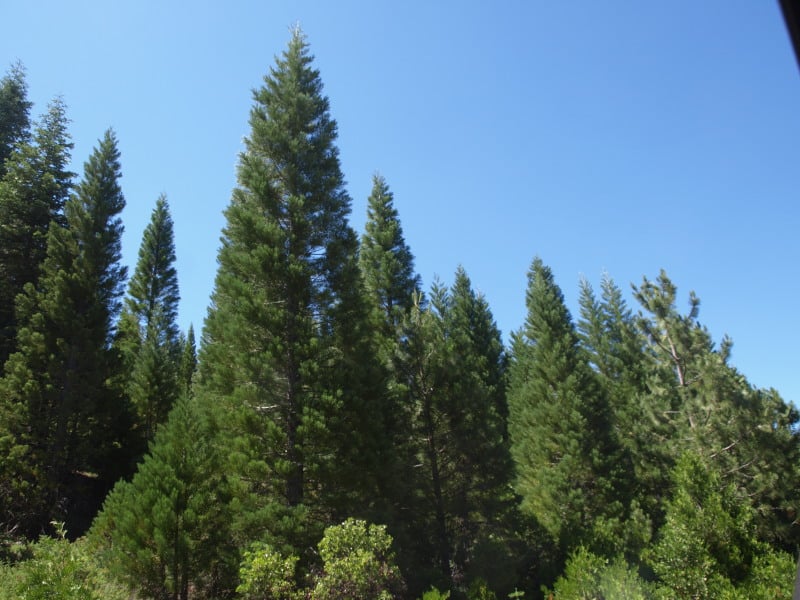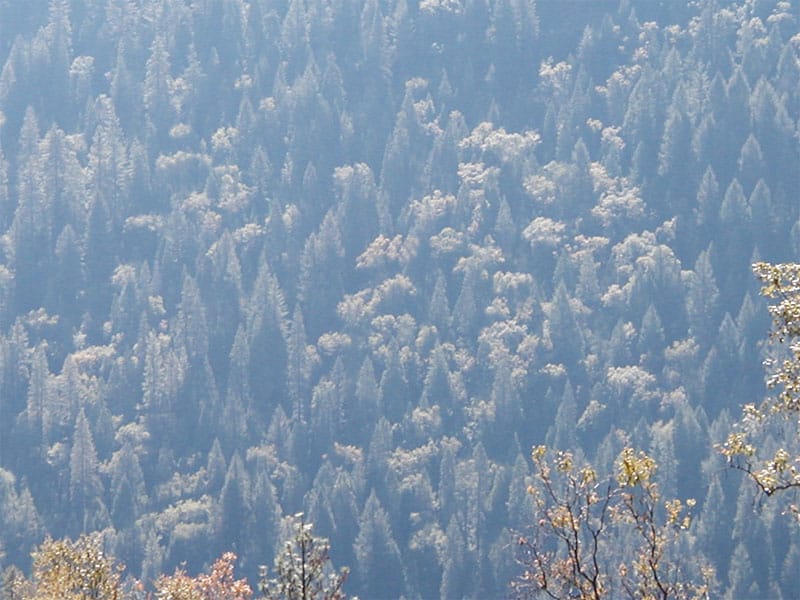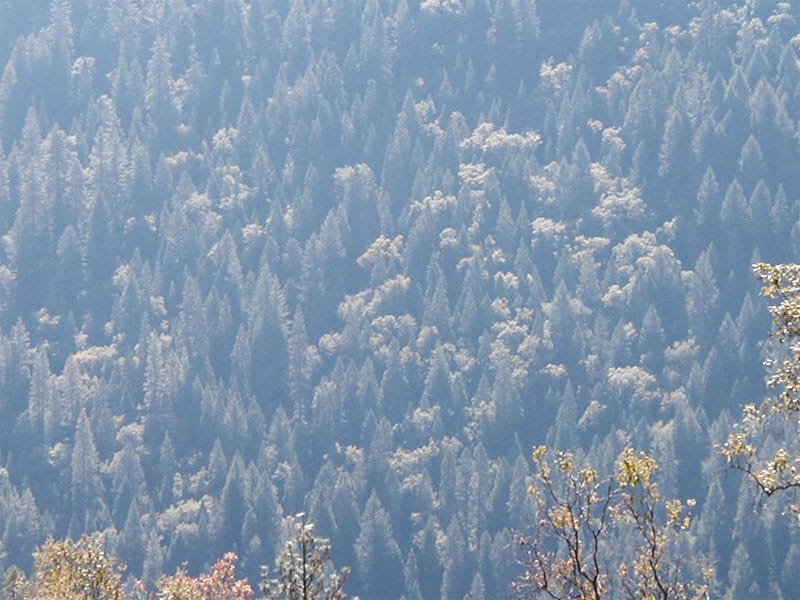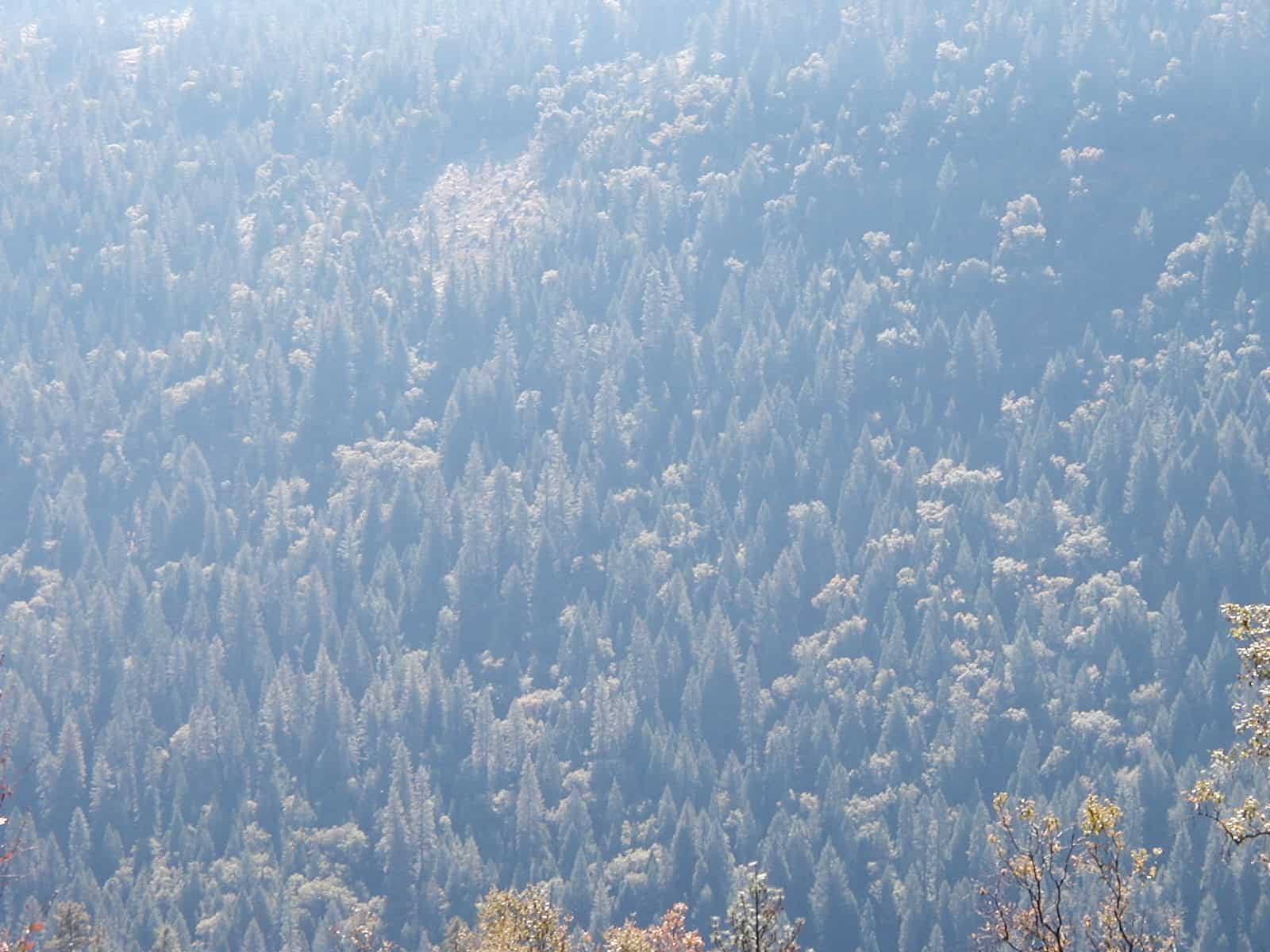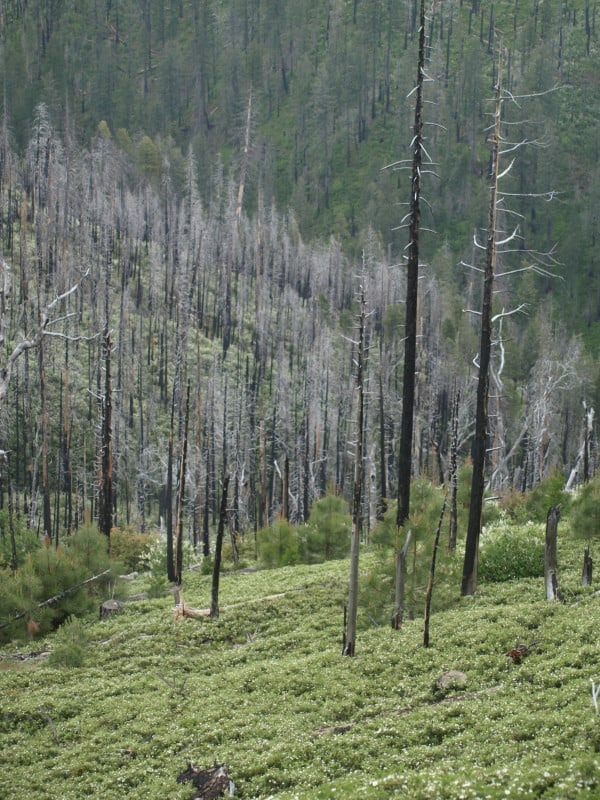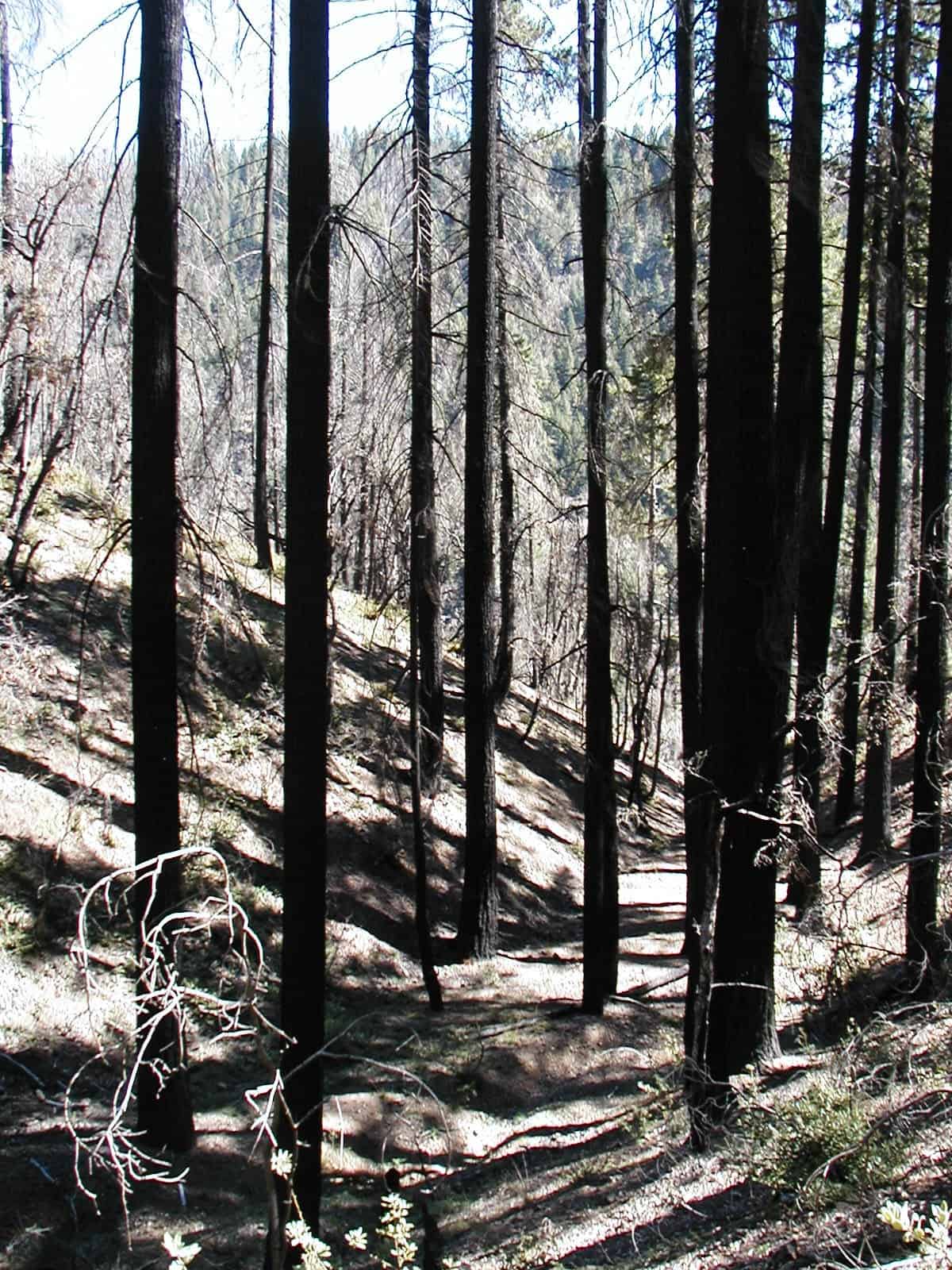We ran across this Giant Sequoia plantation, within our restoration project. I’m not sure of the age of this plantation but, it was probably back in the late 70’s or early 80’s. It is mostly south-facing, and not really like where they normally grow but, a “renegade” culturist did several experiments. I’m not sure what future management ideas are. This one needs some thinning, as their vitality seems quite variable.
Endangered Species Act
Thinning in the Sierra Nevada
I tried my hand at some “digital thinning”, with a picture of the Stanislaus National Forest, above the Mokelumne River. I couldn’t really remove as many of the bigger trees as I should, without sacrificing photorealism. I did “enhance” some of the oaks, which is a keystone of the new paradigm of ecosystem wildlife values. I am sure there are some home habitats of ESA birds, here. There would also be some pockets of undisturbed forest, and maybe some bigger openings around the oaks.
Below is the original picture
I think we can all say that there is, indeed, some excess trees to thin out, in this stand.
Dousing the Claims: Extinguishing Republican Myths about Wildfire
Democrats on the House Resources Committee released a new report on Tuesday. Phil Taylor, a reporter with E&E, has a story out about the report and subsequent hearing. Unfortunately, E&E doesn’t have a free link to the entire story, so some snips from the story are below.
Environmental groups over the past three years have appealed less than 5 percent of projects on federal lands designed to reduce the threat of catastrophic wildfire, and, of those, less than one out of five involved endangered species issues, according to a new report from Democrats on the House Natural Resources Committee….
“Environmental laws, land management agencies, litigation, endangered species and even immigrants share the Republican blame for this year’s devastating wildfires,” Markey said. “These accusations are just a smokescreen.”
Forest Service and Bureau of Land Management data obtained by committee Democrats seemed to back up his claim.
Out of 8,000 fuel reduction projects in federal forests over the last three, less than 1 percent of all of the work was affected by appeals, according to the Democrats’ report. Endangered Species Act challenges affected less than 0.05 percent of all hazardous fuels work on roughly 10 million acres of land, the report found.
“This report shows that political fact-checkers should create a new category called ‘pants on wildfire’ for the ill-informed Republican myths on forest fire prevention,” Markey said. “When climate change is baking the country in drought and actually increasing the risks of catastrophic wildfires, these half-baked ideas from Republicans do a disservice to the people who have suffered from wildfires.”….
Democrats said the findings are consistent with a Government Accountability Office report in 2010 that found less than 20 percent of the 1,191 fuel reduction projects on about 9 million acres from 2006 to 2008 were appealed. About 2 percent of all fuel reduction projects were litigated and those involved about 124,000 acres, the report says.
“An Ecosystem Management Strategy for Sierran Mixed Conifer Forests”
http://www.fs.fed.us/psw/publications/documents/psw_gtr220/
“Description: Current Sierra Nevada forest management is often focused on strategically reducing fuels without an explicit strategy for ecological restoration across the landscape matrix. Summarizing recent scientific literature, we suggest managers produce different stand structures and densities across the landscape using topographic variables (i.e., slope shape, aspect, and slope position) as a guide for varying treatments. Local cool or moist areas, where historically fire would have burned less frequently or at lower severity, would have higher density and canopy cover, providing habitat for sensitive species. In contrast upper, southern-aspect slopes would have low densities of large fire-resistant trees. For thinning, marking rules would be based on crown strata or age cohorts and species, rather than uniform diameter limits. Collectively, our management recommendations emphasize the ecological role of fire, changing climate conditions, sensitive wildlife habitat, and the importance of forest structure heterogeneity.”
This is a basic scientific reasoning for the marking prescriptions we are using in our current project. In scanning through some of it (it seems QUITE comprehensive!), I found this little gem.
‘How is ecological restoration defined in the GTR? In the face of changing
climate conditions, our focus is on increasing ecosystem resiliency. This focus
is consistent with that described in USDA Forest Service Manual 2020.5,
which defines ecological restoration as: “The process of assisting the recovery
of resilience and adaptive capacity of ecosystems that have been degraded,
damaged, or destroyed. Restoration focuses on establishing the composition,
structure, pattern, and ecological processes necessary to make terrestrial and
aquatic ecosystems sustainable, resilient, and healthy under current and future
conditions.” ‘
U.S. FWS Director: Lawsuits not hurting Endangered Species Act
I don’t have a link to the story, but the following article comes from Greenwire. I’m posting it here as a sort of companion piece to the ESA piece Sharon just posted regarding the House Resources Committee Hearing.
Lawsuits not hurting Endangered Species Act – FWS director
By Laura Petersen, E&E ReporterThe House GOP’s campaign against environmental groups that sue the federal government over endangered species management is not the way to improve the Endangered Species Act, according to Fish and Wildlife Service Director Dan Ashe.
“On the scale of the challenges that we face implementing the Endangered Species Act, litigation doesn’t even show up on the radar screen,” Ashe said in an interview this week marking his one-year anniversary as director.
Invasive species, habitat fragmentation, water scarcity, climate change and availability of reliable scientific information are all much more pressing issues than lawsuits, Ashe said.
In an effort to overhaul the Endangered Species Act, House Natural Resources Chairman Doc Hastings (R-Wash.) has focused particularly on the high number of lawsuits brought against the government under the law’s provision that allows citizens to sue if they disagree with a listing decision or a delayed decisionmaking process and have their legal fees paid for if they win.
Hastings has characterized the environmental groups that file suits regularly as “lawsuit-happy organizations that make a living off of suing the federal government” and called litigation costs “one of the greatest weaknesses” of the Endangered Species Act (E&E Daily, June 20).
Ashe dismissed the attacks as a “good sound bite,” noting that the amount of money the agency has paid out in legal fees is a small fraction of the $200 million a year it spends to implement the ESA and hardly enough to support entire nonprofit organizations.
“Can I get frustrated at [Center for Biological Diversity] and WildEarth Guardians, or my good friend Jamie Clark at Defenders [of Wildlife] when they decide to sue us? Yeah, I can,” Ashe said. “But on balance, I think it’s a strength for the Endangered Species Act, and not a weakness.”
The provision has been especially beneficial during presidential administrations that “did not have a friendly view” of implementing the law and protecting imperiled plants and animals, he said.
Last year, FWS struck a massive settlement agreement with environmental groups that set a six-year timeline for the agency to make decisions on 251 candidate species and initial findings on hundreds of other species. In exchange, the groups promised to not file more lawsuits.
The settlement has been “quite a success,” with both sides being “faithful” to the bargain, Ashe said.
Asked how he would reform the Endangered Species Act, Ashe said “reform is too strong of a word.”
However, he said the law can be better. The biggest improvement he would like to make is to increase financial incentives for endangered species conservation.
Study: Fish and Wildlife Service Routinely Ignored Scientific Experts
The following was just released by the Center for Biological Diversity:
A new study in the international journal Bioscience finds that the U.S. Fish and Wildlife Service routinely ignored scientific peer review when designating protected critical habitat for endangered species. According to the study published this month, the agency ignored recommendations by scientific experts to add areas to critical habitat to ensure the survival and recovery of endangered species 92 percent of the time.
“Our study shows the U.S. Fish and Wildlife Service completely failed to rely on the best available science when deciding which habitat to protect for some of America’s most endangered species,” said Noah Greenwald, endangered species director at the Center for Biological Diversity and lead author of the peer-reviewed study. “This isn’t some meaningless bureaucratic oversight. Ignoring scientists’ advice jeopardizes the survival and recovery of endangered species.”
The designation of critical habitat is a key step in protecting the most important areas used by endangered species. Species with protected critical habitat are twice as likely to be recovering as those without it. As part of making a designation, the Fish and Wildlife Service must have experts outside the agency review the proposed designation to make sure it’s scientifically sound and suitable to help species survive and recover.
Using data obtained through the Freedom of Information Act, the study reviewed 169 peer reviews of 42 critical habitat designations for 336 species covering a five-year period (2002-2007). Of the 169 reviews, 85 recommended adding areas and 19 recommended subtracting areas. In response, the agency added areas in only four cases and subtracted areas in only nine cases. After peer review, 81 percent (34) of the 42 critical habitat designations were reduced by an average of 43 percent.
“Routinely, the agency dismisses scientific advice on the grounds that they need ‘flexibility’ to better serve endangered species,” said Stuart Pimm, chair of conservation at Duke University and one of the study’s authors. “There is absolutely no evidence that, in consistently denying threatened species their needed habitats, any species has benefitted.”
In addition to examining the peer reviews, the study presented case studies examining the process for designating critical habitat for the southwestern willow flycatcher and Cape Sable seaside sparrow. In the case of the flycatcher, the peer reviewers faulted the proposed designation for failing to include areas recommended by a scientific recovery plan. Rather than add additional areas, however, the agency cut the designation by 53 percent at the behest of a former political appointee at the Department of the Interior. In the case of the sparrow, the agency cut an area from critical habitat against the advice of peer reviewers (one of whom described the area as “extremely important”) based on the false premise that designation of critical habitat would conflict with Everglades restoration.
“Science, not politics, ought to drive which habitat is protected for endangered species,” said Greenwald. “Obtaining peer review shouldn’t simply be about checking off a box on a form. Saving species means saving the places they live and, when it comes to that, our best scientists need to be listened to.”
The study is the first to systematically examine a government agency’s response to peer review of its decisions. Peer review of government decisions is fundamentally different from peer review of scientific studies in that there is no editor to determine whether peer review has been properly considered or, if appropriate, followed. To rectify this situation, the study recommends appointing an arbiter to oversee the government’s response to peer review and giving agency scientists more independence to ensure closer adherence to scientific information.
The Power Fire, and the Blackbacked Woodpecker
This helicopter unit experienced significant dieback, even as the fallers returned multiple times. The marking guidelines allowed for cutting trees with low crown ratios, and with the Forest Service getting projects together so quickly (six months!), the bark beetles hadn’t run their course, yet. In addition to the snag specifications in the project’s plans, you can clearly see that there are a great many more snags now, than the plans required. Also important in this is that snag of certain sizes had to be cut and flown out, as part of the fuels treatment (a HUGE expenditure!) The Power Fire salvage project was halted by the Ninth Circuit Court, due to the new salvage marking guidelines, and a perceived need for more blackbacked woodpecker analysis. The cutting unit below was completed, though.
Also seen in the foreground is that nasty bear clover, which will dominate, until it is shaded out, or killed with herbicides. It is great to have this smelly carpet (AKA mountain misery) under a nice canopy but, in this case, it will hinder all trees from germinating and growing. Their roots can go 12 feet deep. Even the deerbrush is kept at bay by the bear clover.
On Time, On Target: How the ESA is saving America’s Wildlife
The Center for Biological Diversity just keeps on pumping it out. Today, they released this new report (PDF). The Executive Summary is pasted below.
Critics of the Endangered Species Act contend it is a failure because only 1 percent of the species under its protection have recovered and been delisted. The critique, however, is undermined by its failure to explain how many species should have recovered by now. It is a ship without an anchor.
To objectively test whether the Endangered Species Act is recovering species at a sufficient rate, we compared the actual recovery rate of 110 species with the projected recovery rate in their federal recovery plans. The species range over all 50 states, include all major taxonomic groups, and have a diversity of listing lengths.
We found that the Endangered Species Act has a remarkably successful recovery rate: 90 percent of species are recovering at the rate specified by their federal recovery plan.
On average, species recovered in 25 years, while their recovery plan predicted 23 years — a 91 percent timeliness accomplishment.
We confirmed the conclusion of scientists and auditors who assert that the great majority of species have not been listed long enough to warrant an expectation of recovery: 80 percent of species have not yet reached their expected recovery year. On average, these species have been listed for just 32 years, while their recovery plans required 46 years of listing.
Many species that have not been listed long enough to reach their recovery goals increased dramatically since being protected by the Endangered Species Act:
California least tern 2,819% increase in nesting pairs San Miguel island fox 3,830% increase in wild foxes Black-footed ferret 8,280% increase in the fall population Atlantic green sea turtle 2,206% increase in nesting females on Florida beaches El Segundo blue butterfly 22,312% increase in butterflies While many species are near or above the numeric population goal set by their recovery plan and will likely be delisted in the next 10 to 15 years, others also have strong recovery trends, but will not be delisted for many decades because their recovery plans require that much time to fully secure their fate.
The study’s findings are similar to a 2006 analysis of all federally protected species in the Northeast, which found 93 percent were stabilized or improving since being put on the endangered species list and 82 percent were on pace to meet recovery goals.
When judged in the light of meeting recovery plan timelines for recovery, the Endangered Species Act is remarkably successful. Few laws of any kind can boast a 90 percent success rate.
Biscuit “Scenic” Pictures
This is an example of a “protected” nesting site for a northern spotted owl. It was never logged and will not be habitat for many decades, especially if a reburn occurs. It sure doesn’t look “natural and beneficial”, to me, OR the owls and goshawks.
Here are the kind of snags (the large orange-marked one) that were selected to be “saved”, within Biscuit cutting units. Of course, only 4% of the 500,000 acres of the Biscuit were salvaged, so there certainly is no lack of snags in the huge burn.
Here is a cutting unit where mortality was close to 100%, in unlogged old growth. Instead of thinning a green stand, we ended up “thinning” snags.
Here is some erosion, in a small gully. I wonder what the “cumulative impacts” of hundreds of similar gullies have upon salmon populations, and other aquatic organisms. Surely, some of these gullies experienced accelerated erosion in the 5+ years since I took this picture.
